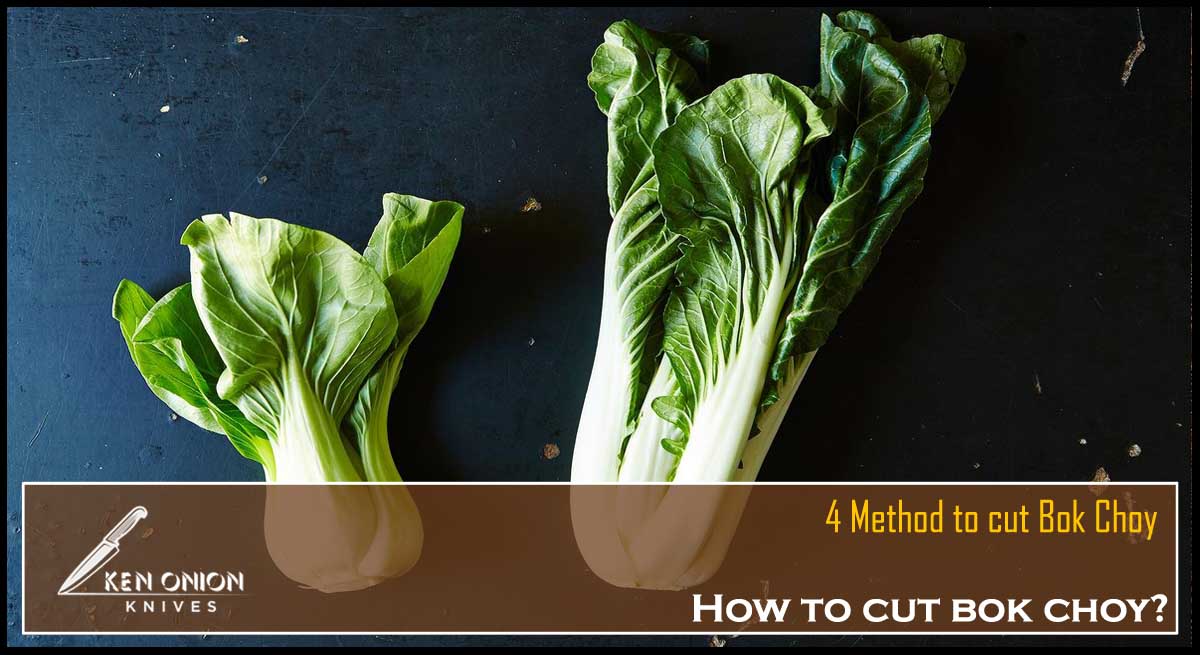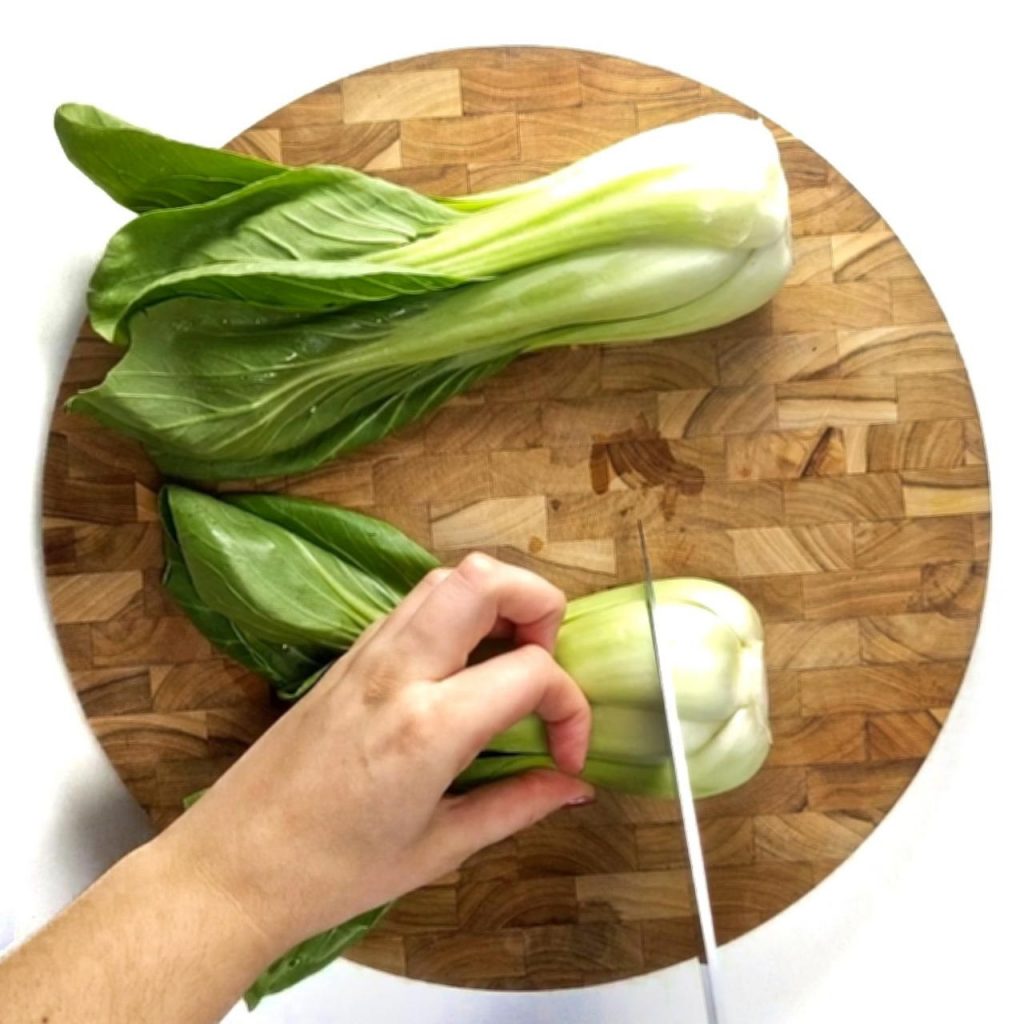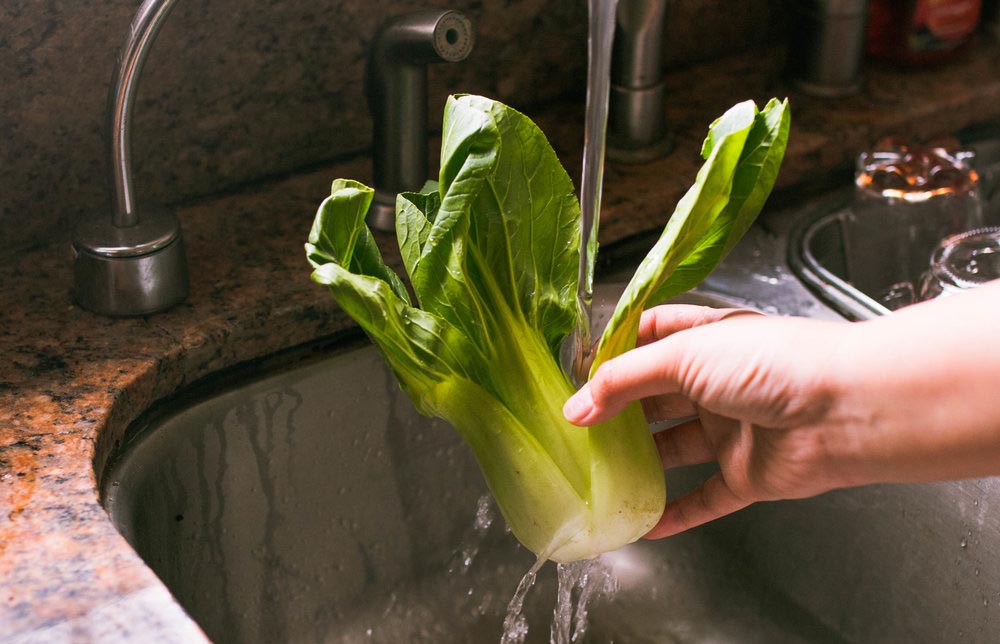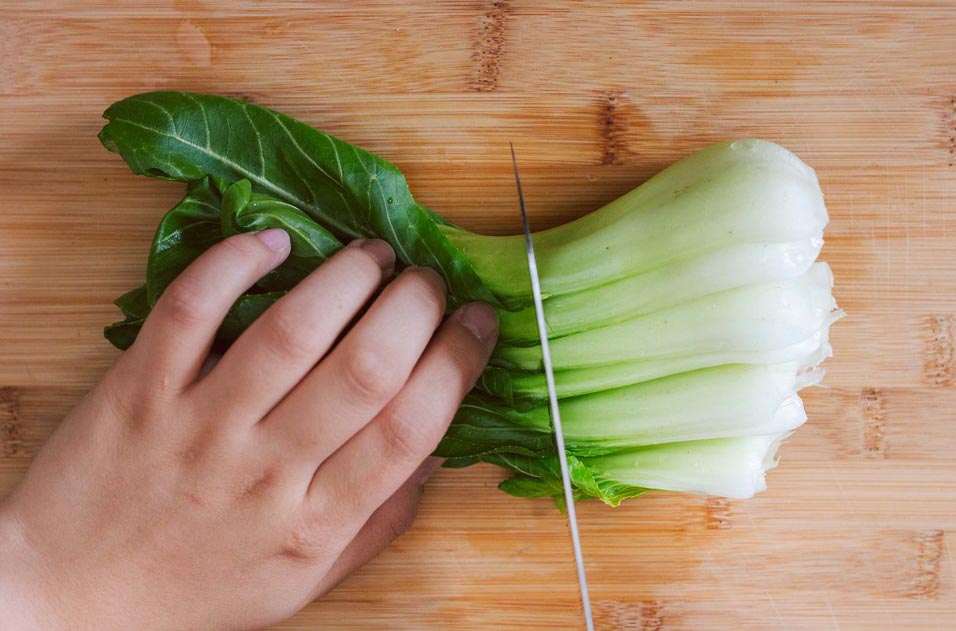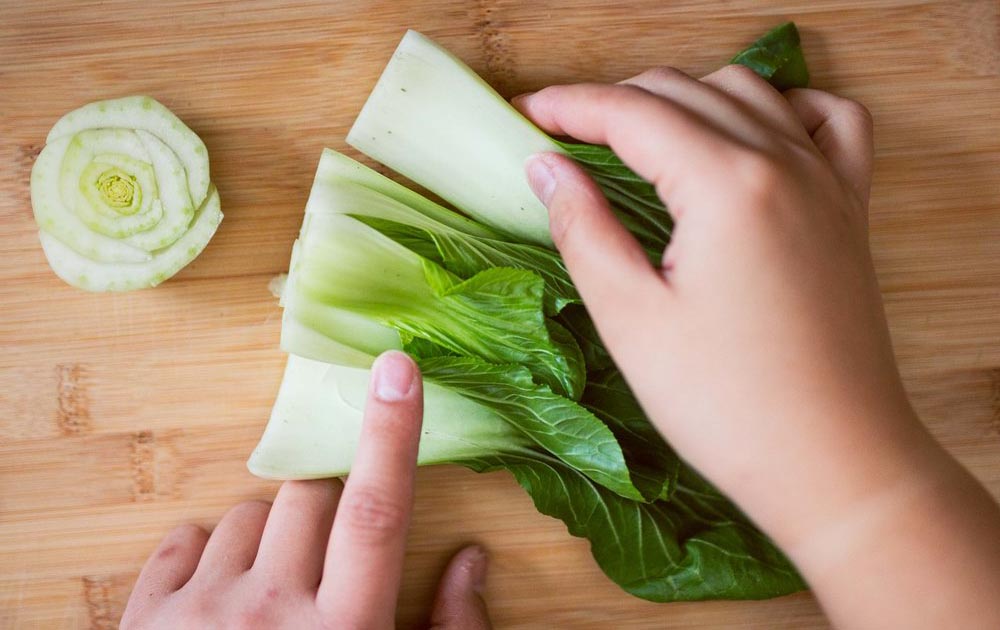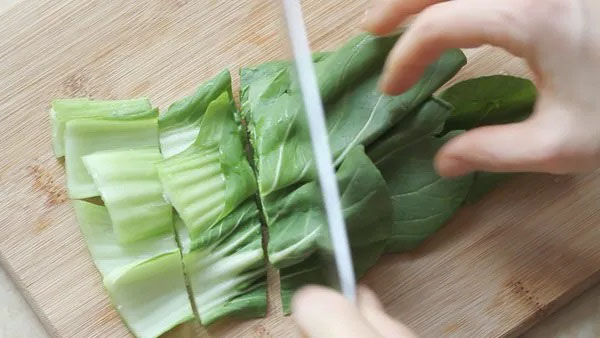How to cut bok choy? – Recommended Equipment Used To
Are you looking for How To Cut Bok Choy? Bok choy is a type of Chinese cabbage that has become increasingly popular in the United States in recent years. It is a nutrient-rich vegetable that can be cooked in a variety of ways, making it a versatile addition to any meal.
Although it can be eaten raw in salads, bok choy is often cooked due to its high-water content. This cruciferous vegetable is low in calories and carbohydrates, but high in essential vitamins and minerals. This article provides instructions on how to chop bok choy so that it can be used in recipes.
Bok choy is a healthy and delicious addition to any meal. In this article, we will show you how to cut bok choy for use in your favorite recipes.
What is bok choy?
Bok choy, also known as Chinese cabbage, is a leafy green vegetable that is a member of the Brassica family. This veggie is commonly used in Asian cuisine and has a mild, slightly sweet flavor. Bok choy is an excellent source of vitamins A, C, and K, as well as calcium and iron.
Bok choy nutrition.
One cup of chopped, cooked bok choy contains:
Calories: 9
Protein: 1.3 grams
Carbs: 1.7 grams
Fiber: 0.6 grams
Vitamin A: 61% of the Daily Value (DV)
Vitamin C: 74% of the DV
Vitamin K: 535% of the DV
Calcium: 10% of the DV
Iron: 4% of the DV
Health benefits. Bok choy is packed with nutrients that offer a variety of health benefits. These include improving bone health, boosting immunity, and reducing inflammation. Additionally, bok choy is a low-calorie food that is high in fiber, making it beneficial for weight loss. See more about bok choy nutrition on Healthline
How to select bok choy?
When selecting bok choy, look for crisp, dark green leaves with firm white stalks. Avoid any wilted or yellowing leaves, as well as those with blemishes or bruising. Bok choy can be stored in the fridge for up to four days. To extend its shelf life, wrap it in a damp paper towel before placing it in a plastic bag in the crisper drawer.
How to clean bok choy.
1. Rinse the bok choy in cold water:
Make sure to rinse your bok choy in cold water before cooking or eating it. This will help remove any dirt or debris that may be on the vegetable!
2. Cut off the bottom of the stem:
The bottom of the stem is where all the dirt and grime tend to accumulate. To clean it properly, cut off this part of the bok choy before washing!
3. Slice the bok choy into thin strips:
Thin strips of bok choy are easier to wash than large pieces. To make them, start by slicing off the top leaves and then cutting the stalk into thin strips that are about 1-2 inches (2.5-5 cm) wide!
4. Soak the bok choy in a bowl of cold water:
After you’ve cut the bok choy into thin strips, soak them in a bowl of cold water for 5-10 minutes. This will help remove any remaining dirt or debris!
5. Rinse the bok choy one last time:
Once you’ve soaked the bok choy, make sure to rinse it one last time under cold water. This will ensure that all the dirt and grime are gone before you cook or eat it!
How to cut bok choy?
Method1. Choosing and Washing Your Bok Choy
1. Choose bok choy with bright green leaves and crisp stalks:
You can recognize fresh bok choy by its bright green leaves and crisp white stalks without holes. Avoid any bunch that looks rubbery or dried out towards the stem as it will taste terrible! crunchy is good for you too.
Bok choy, also known as pak choi is a versatile vegetable that can be found in many varieties. These include different flavors and sizes to suit any palate!
The variety of vegetables available for sale is vast and diverse, but if you’re looking to buy some that will work well in a soup or salad recipe then choose smaller leaves. On the other hand, large leafy varieties are best suited as ingredients when creating stir-fries dishes since they have more flavor than small ones do.
2. Buy baby bok choy for a milder flavor:
The baby bok choy is a smaller variety than the regular one. It has thicker stems and smaller leaves compared to when it’s fully grown, but otherwise, its flavor profile remains similar: milder than mature ones with more tender stalks that can be eaten in any stage from green sprouts right up until harvest time!
The whole baby bok choy is appealing because you can cook the vegetable without needing to break apart any leaves.
3. Store your bok choy in a plastic bag in the fridge for up to 5 days:
Store your bok choy in a grocery store plastic produce bag to keep it fresh for 5 days. Run the stalk of this leafy vegetable along its length, then twist shut and store away from other foods at room temperature!
4. Trim and discard the thick base of the bok choy stem:
With a sharp knife, cut the bottom 1⁄2 to 1 inch (1.3 cm to 2.5 cm) just above where leaves connect, and pull off any outside ones that are discolored or particularly tough- you’ll be left with many long individual bok choy stalks.
5. Wash the individual bok choy stalks in a bowl of cold water:
Separate the leaves and swish them around in a large bowl full of cold water. Gently rub each leaf against its corresponding side to remove any dirt before draining through an incubator—or worse yet, your kitchen sink!
If you would rather scrub your rice under cold running water, I’d recommend doing so.
The base of each stalk is where dirt tends to collect. So, be sure you clean them first!
Method2: Slicing Bok Choy
1. Bunch the stalks together and slice off the white stems:
Now, group all the stalks together and cut them off with a knife. Use your blade to separate any thick white stems from green leaves on top so that you have an even bunching for easier cooking later!
Keeping the stems and leaves separate is helpful because they cook at different rates. The stem will be slower than any other part of your plant, so cooking it helps maintain its shape while ensuring that you don’t overcook other vital parts!
2. Hold the bok choy in a stable position using a claw-like grip:
To get a good grip on the vegetable, curl it inwards with just your fingertips. This will protect against knife slipping and keep you safe!
3. Hold your knife at a 45-degree angle over the bok choy stems:
Hold your knife at a 45-degree angle to make slanted cuts across the stem of bok choy. This will increase how much surface area there is on each piece, which cooks faster because it doesn’t take as long for water vapor exchange between inside and outside cells when exposed only slightly above ground level like in this type of food product!
4. Slice the bok choy into 1 in (2.5 cm) sections:
To cut the stems into 1 in (2.5 cm) sections, start at the base and slice up to the top where it becomes green leaves. Next, hold bok choy with one hand away from the knife while doing this same process for the other side so both sides are evenly divided into small pieces!
To make your cuts thinner if you’re looking to create a stir-fry.
Method 3. How to cut Bok Choy Into Rectangles:
1. Cut an individual stalk in half down the middle:
For a perfect flower, cut the stalk of an individual white blending it with its paired half. Lay these two pieces next to each other on your cutting board and you’ll have yourself one beautiful arrangement!
Trim your bok choy stalk into thirds if you want thinner, more pristine looking slices.
When you want to cook with an array of different vegetables or meats, the rectangle cutting board is your best bet. This type allows for more diverse cooking methods than other shapes such as circles and triangles which can make it easier when using various combinations at once!
2. Separate the green leaves from the white stem:
To get the most nutrients from your bok choy, it’s best not to remove any leaves. If you must cut them off for some reason or another just slice them into thin pieces along their length with a knife and keep those!
3. Cut the stem into 1 in (2.5 cm) long rectangular pieces:
To get a good result, make sure you cut your stem into roughly the shape of rectangles. Read more on how to chop bok choy above for more details. These pieces should be thick!
Method4. Dicing Bok Choy.
1. Cut the leaves off the bok choy.
With one stalk of bok choy still attached to the leafy top, cut it off. You should be left with only a white stem now!
Diced bok choy is great in soups and salads!
2. Slice the stem vertically into 3 long strips:
The larger knife is perfect for making long, smooth cuts. Make sure to keep the strips about equal in width and length so they all cook at once
3. Cut the strips horizontally into small 1⁄2 in (1.3 cm) long diced pieces:
To dice a stem into small pieces, bunch the strips together with your non-dominant hand and carefully cut down from one end. Make sure you’re only making 1⁄2 in (1.3 cm) long dice—if they are any larger than this it will be difficult to chew them without risking injury!
Recommended Equipment to cut bok choy.
These bamboo cutting boards are the best I’ve ever used to cut bok choy. Not only do they look great in my kitchen, but the rubber stoppers on their bottoms help prevent them from slipping when you’re using them to cut food with a blade as sharp as a chef’s knife.
- This 3-piece set includes a small board, perfect for taking on trips; a medium-sized board, ideal for small chopping tasks; and a large board, perfect for party meal prep.
- Made from smooth bamboo wood, our cutting boards will not dull your knives and are easy to clean. Plus, there will be no scratches or marks on the cutting surface.
- Whether you're slicing, dicing, or chopping, our high-quality cutting boards will make meal prep a breeze. So start your culinary journey today with the Bamboo Cutting Board set.
Besides, the specialized knives for cutting vegetables below are used by chefs with a wooden cutting board to cut the most beautiful pieces of bok choy.
- Cook like a pro with this high-carbon Cr17 stainless steel chef knife. The steel contains 0.6-0.75 carbon, making it two times as hard as other knives in its class.
- The special waved pattern blade is particularly striking and comes with an HRC of 57-58, making it one of the toughest knives around.
- The ergonomic shape of the Pakka Wood handle enables the right balance between the handle and the thin blade, ensuring ease of movement and comfort while you cook.
How to cut bok choy into halves or quarters.
1. Start by cutting off the bottom of the stem:
The bottom of the stem is where all the dirt and grime tend to accumulate. To clean it properly, cut off this part of the bok choy before washing!
2. Slice the bok choy in half lengthwise:
If you want to cut the bok choy into halves or quarters, start by slicing it in half lengthwise. Once you’ve done this, you can either leave it as is or slice it into smaller pieces!
3. How to cut the bok choy into strips:
If you want to cut the bok choy into strips, start by slicing off the top leaves and then cutting the stalk into thin strips that are about 1-2 inches (2.5-5 cm) wide!
How to cut bok choy into leaves.
1. Start by cutting off the bottom of the stem:
The bottom of the stem is where all the dirt and grime tend to accumulate. To clean it properly, cut off this part of the bok choy before washing!
2. Slice the bok choy into thin strips:
Thin strips of bok choy are easier to wash than large pieces. To make them, start by slicing off the top leaves and then cutting the stalk into thin strips that are about 1-2 inches (2.5-5 cm) wide!
3. Cut the strips into smaller pieces:
If you want to cut the bok choy into leaves, start by slicing off the top leaves and then cutting the stalk into thin strips that are about 1-2 inches (2.5-5 cm) wide. Once you’ve done this, cut the strips into smaller pieces that are about 1-2 inches (2.5-5 cm) long!
4. Rinse the bok choy one last time:
Once you’ve cut the bok choy into leaves, make sure to rinse them one last time under cold water. This will ensure that all the dirt and grime are gone before you cook or eat them!
Bok choy is a great addition to soups, stews, and stir-fries! It’s also delicious on its own as a side dish or in salads.
How to cut bok choy for soup.
1. Rinse the bok choy in cold water:
Make sure to rinse your bok choy in cold water before adding it to any dish. This will help remove any dirt or debris that may be on the vegetable!
2. Cut off the bottom of the stem:
The bottom of the stem is where all the dirt and grime tend to accumulate. To clean it properly, cut off this part of the bok choy before adding it to your dish!
3. Slice the bok choy into thin strips:
Thin strips of bok choy are easier to cook than large pieces. To make them, start by slicing off the top leaves and then cutting the stalk into thin strips that are about 1-2 inches (2.5-5 cm) wide!
4. Add the bok choy to your dish:
Once you’ve cut the bok choy into thin strips, add it to your soup, stew, or stir-fry!
How to chop bok choy.
1. Start by cutting off the bottom of the stem:
The bottom of the stem is where all the dirt and grime tend to accumulate. To clean it properly, cut off this part of the bok choy before chopping!
2. Slice the bok choy in half lengthwise:
If you want to chop the bok choy into small pieces, start by slicing it in half lengthwise. Once you’ve done this, you can either leave it as is or slice it into smaller pieces!
3. How to chop bok choy into strips:
If you want to chop the bok choy into small pieces, start by slicing off the top leaves and then cutting the stalk into thin strips that are about 1-2 inches (2.5-5 cm) wide!
4. Cut the strips into smaller pieces:
Once you’ve cut the bok choy into strips, cut them into smaller pieces that are about 1-2 inches (2.5-5 cm) long.
5. Rinse the bok choy one last time:
Once you’ve chopped the bok choy into small pieces, make sure to rinse them one last time under cold water. This will ensure that all the dirt and grime are gone before you cook or eat them!
How to Store Bok Choy Before Use?
You now know how to cut bok choy, we continue to guide you in-store bok choy before use. You can tell if a plant is fresh by looking at its surface. If there are dark spots on the leaves or stem, then that means it has been sitting in storage for too long and should be discarded because of this condition called wilting.
Store your bok choy in a dark, cool place and make sure that it isn’t wet before storing. This will help prevent wilted leaves from happening!
You want to go with a sealed bag so that you can keep all your groceries fresh and safe. You will need one of those resealable plastic grocery bags, or maybe even two!
Effective sealing methods are important to prevent any leakage during shipping. Choose resealable plastic bags that can be sealed in a vacuum for an airtight package!
With your hands, gently squeeze the bag to release any excess air. Seal it shut once you’ve removed all its contents and placed them in an open container or paper cups for disposal later down the line!
Put the bok choy in a bag and keep it at the bottom of your fridge, next to other produce.
The moment you get your produce, take it out of the fridge and wash it only immediately before using it. This will prevent wilting!
To get the most from your leaves, you should pat them dry with a paper towel. You can also use an old shirt or other cloth that is not too see-through to protect their delicate fragrance as well!
Bok choy is an excellent vegetable to keep in the fridge. It can be refrigerated for up to 4 days before its flavor starts changing, but it’s best when used within a few days of purchasing so that way you don’t end up wasting any food!
Bok choy is an excellent vegetable to have on hand. It can be stored in the fridge for up to three days or freezer indefinitely, but it won’t taste as good after being taken out of storage!
How to cook bok choy?
After learning about how to cut bok choy, the cooking method is equally important. The easiest way to cook bok choy is by steaming. It’s important not to overcook the stems, which will make it mushy and unpleasant tasting! The best time for this vegetable according to an expert interviewed in The Kitchen, is between 5 – 8 minutes depending on how large your piece of veggies is.
Whether you’re preparing it for a main dish or side, bok choy will be the star of your show. You prefer buying whole pieces so that they can take their time getting tender without becoming overcooked before being added to other dishes; however, if chopped more efficiently than small amounts only need 5-7 minutes per batch when stir-frying/sautéing!
Stir-fry to maximize the flavor
To get a good amount of browning and flavor development, you prefer to stir-fry baby bok choy. You can use either an oversized wok or nonstick skillet for this task – just make sure that you cut down the center so it’s ready by cutting out two halves!
Once the cut sections have been cooked in hot oil, turn them over and cook on the other side. When both sides are golden brown, put through your favorite stir-fry sauce for an extra burst of flavor!
Flavor boosters
The aromatics and sauces will create layers of flavor as you cook them. Minced ginger and garlic cloves are added to the pot for an instant pungency along with green onions that can be sliced or minced depending on your preference – all these ingredients will give the final dish an aromatic quality.
Soy sauce, oyster sauce, and Shaoxing wine are all classic ingredients used in stir-fries! You can use any of them to deglaze the pan and create a flavorful sauce that coats each piece of bok choy.
To flavor the sauce, soybean paste is added at the end of cooking. It’s a delicious combination that includes rice vinegar and sesame oil with honey for sweetness as well chili flakes to spice things up! When stir-fried together this creates an unforgettable glazed bok choy dish
Ways to use bok choy
Bok choy can be used in a variety of dishes. It’s mostly found in soups and stir-fries, but it can also be used as a side dish or even eaten raw!
Soups: Bok choy is often used as an ingredient in soups such as wonton soup, chicken noodle soup, and hot and sour soup.
Stir-fries: Bok choy is a popular vegetable to use in stir-fries. It’s often paired with other ingredients such as chicken, shrimp, beef, or pork.
Side dish: Bok choy can be served as a side dish. It can be steamed, sautéed, or even grilled!
Raw: Bok choy can be eaten raw. It can be added to salads or used as a garnish.
Can you freeze bok choy?
Yes, the process of freezing raw bok choy is a delicate one. To avoid the soggy mess that can result from improperly thawed vegetables, you need to blanch them first before placing them in freezer bags or containers for storage. This will eliminate any enzymes present in your dish which may change its flavor and texture as well!
Blanching is a fantastic way to keep vegetables bright, colorful, and delicious. The process involves briefly immersing the veggies in boiling water or steam then immediately dipping them into ice cold waters, so they don’t continue cooking any longer- this gives you great results every time. Before bearing bok choy, be sure to read 4 methods on how to cut bok choy carefully.
To make sure your bok choy is fresh and crisp, it’s best not to blanch them before freezing. However, if you do want a more processed look for those who prefer their vegetables that way then just grab some uncooked pieces from the produce section of the grocery store!
After know about how to chop bok choy, you should freeze bok choy after cutting it
How to freeze fresh bok choy?
To ensure that your bok choy is safe to eat, you should first scorch it. The vegetable must be washed and dried before freezing since any residual water could cause them to become mushy when thawed out later down the line!
Remove the yellow leaves:
Handle yellowing leaves with care because they can be infectious. Discard any pale or soft-leaved plants to avoid the risk of spreading diseases, so your bush will look fresh for years!
Chop the bok choy:
How to chop bok choy? If you have the time, it is best to shred regular sized bok choy into smaller bite-sized pieces. Baby versions can be frozen whole for future use in soups or stir cookers without worrying about cooking them again when they are already cooked!
Place the bok choy in a freezer bag:
Guide your bok choy to the freezer by following these simple steps. Place it in a sealed bag and date it with written time, then place heavy things on top so as not to damage them too much while they’re freezing!
How to keep bok choy frozen well?
To freeze bok choy, first, determine how much you want to save and then cut it into pieces. Place these in a labeled Ziploc bag with the date that they were frozen on top for reference later when cooking; this way we can use up all our old vegetables without having any wonder what went wrong!
The first step to making your own vacuum sealer is by placing the Ziploc bag flat and closing it almost completely, leaving just enough space for your straw so that when sucked out all air from inside before sealing. You can also use various bags because this will save time as well!
When freezing bok choy, make sure the Ziploc bag is flat in your freezer. If you need to shift it around so that other meals fit better before they are ready for use then do not hesitate!
FAQs about How to cut bok choy?
Why should you eat bok choy?
Bok choy is a great source of vitamins A, C, and K, as well as folate and manganese. It’s also a good source of calcium, copper, iron, magnesium, phosphorus, selenium, and zinc. All of these nutrients are important for maintaining good health!
Is bok choy and baby bok choy the same?
No, bok choy is a type of cabbage while baby bok choy is a leafy vegetable. Bok choy has white stalks with green leaves while baby bok choy is all green. Both are safe to eat and have a slightly bitter taste.
What is the difference between bok choy and Napa cabbage?
Napa cabbage is a type of Chinese cabbage that has bluish-green leaves and a milder flavor than regular cabbage. Bok choy, on the other hand, has white stalks with dark green leaves and a slightly bitter taste. Both are safe to eat and can be used in many different recipes.
Does bok choy need to be cut?
Yes, you will need to cut bok choy before eating it. The white stalks can be tough, and the leaves are too big to eat whole. cutting them into smaller pieces will make them easier to eat and cook. Read above to know about how to cut bok choy.
How do you clean bok choy?
It is best to wash bok choy in a colander or strainer under cold, running water. You may need to rinse them more than once to get all the dirt and sand out. Once they are clean, pat them dry with a towel or let them air dry before using.
What part of the bok choy do you eat?
You can eat both the leaves and the stalks of bok choy. The stalks are white and crunchy while the leaves are dark green and slightly bitter. Both parts of the plant are safe to eat and can be used in many different recipes. Before eating, be sure to read 4 methods on how to cut bok choy carefully.
What part of bok choy do you eat?
Bok choy is a leafy vegetable, so the entire plant is edible. The leaves are tender and have a mild flavor, while the stems are slightly tougher with a slightly bitter taste.
How do you prepare bok choy for stir fry?
If you are stirring frying bok choy, you will need to clean it and cut it into small pieces. It is best to cut the stalks into 1-inch pieces and the leaves into 2-inch pieces. Once it is cut, you can add it to your stir fry recipe.
What can I substitute for bok choy in a recipe?
If you cannot find bok choy, you can substitute Napa cabbage, Swiss chard, or kale. All these vegetables have a similar taste and texture to bok choy. Read more about how to chop bok choy above for more details
What is the best way to cook bok choy?
There are many ways to cook bok choy. You can stir fry it, steam it, or even eat it raw. The best way to cook bok choy will depend on your personal preferences.
What is the nutritional value of bok choy?
Bok choy is a low-calorie vegetable that is high in vitamins and minerals. It is an excellent source of vitamin C, potassium, and calcium. Bok choy is also a good source of fiber and protein.
What are the benefits of eating bok choy?
Bok choy is a healthy vegetable that has many benefits. It is low in calories and fat, and it is high in vitamins and minerals. Bok choy is also a good source of fiber and protein. Eating bok choy can help you reach your daily recommended intake of fruits and vegetables.
How many calories are in bok choy?
There are only 9 calories in a cup of chopped bok choy. This makes it a low-calorie vegetable that is perfect for people who are trying to lose weight.
Is bok choy a good source of fiber?
Yes, bok choy is a good source of fiber. Fiber is an important nutrient that can help you feel full and satisfied after eating. It can also help to regulate your digestive system.
Is bok choy a good source of protein?
Yes, bok choy is a good source of protein. Protein is an important nutrient that helps your body to build and repair cells. It can also help you to feel full and satisfied after eating.
Is bok choy good for weight loss?
Yes, bok choy is good for weight loss. This is because it is a low-calorie vegetable that is high in vitamins and minerals. Bok choy is also a good source of fiber and protein. Eating bok choy can help you reach your daily recommended intake of fruits and vegetables.
How much should I cut off bok choy?
It is the best way how to cut bok choy into small pieces before eating or cooking. This will make them easier to eat and cook. You can cut the stalks into 1-inch pieces and the leaves into 1-inch pieces.
Can I eat bok choy raw?
Yes, you can eat bok choy raw. Raw bok choy has a slightly bitter taste, but it is safe to eat. If you are going to eat bok choy raw, it is best to wash it and cut it into small pieces. You can also add it to salads or smoothies.
Is bok choy healthier raw or cooked?
There is no definitive answer to this question. Both raw and cooked bok choy are healthy vegetables that are high in vitamins and minerals. Raw bok choy may retain more of its nutrients, but it can also have a bitter taste. Cooked bok choy is easier to eat and digest, but it may lose some of its nutrients during the cooking process.
Is bok choy a carb?
No, bok choy is not a carb. It is a low-calorie vegetable that is high in vitamins and minerals. Bok choy is also a good source of fiber and protein.
Can I eat bok choy if I am on a diet?
Yes, you can eat bok choy if you are on a diet. This is because it is a low-calorie vegetable that is high in vitamins and minerals. Bok choy is also a good source of fiber and protein. Eating bok choy can help you reach your daily recommended intake of fruits and vegetables.
Does bok choy have any side effects?
The cruciferous vegetables such as raw bok choy are a great source of nutrients and contain an enzyme called myrosinase. Myrosinase can hinder thyroid function by preventing the body from absorbing iodine, but cooking deactivates it so you don’t need to worry about eating too many calories or strange ingredients if this is something that interests you!
Is bok choy toxic?
The bok choy plant contains glucosinolates, which have been reported to prevent cancer in small doses but can be toxic if taken too much by humans.
Is it good to eat bok choy every day?
Yes, it is good to eat bok choy every day. This is because it is a low-calorie vegetable that is high in vitamins and minerals. Bok choy is also a good source of fiber and protein. Eating bok choy can help you reach your daily recommended intake of fruits and vegetables.
Does bok choy grow back after cutting?
Yes, bok choy will grow back after cutting. This is because it is a fast-growing vegetable. Bok choy can be harvested within 2-3 weeks after planting.
Can you eat bok choy leaves with holes?
Yes, you can eat bok choy leaves with holes. This is because the holes are caused by insect damage and do not affect the taste or safety of the leaf.
How do I know when bok choy is ready to harvest?
Bok choy is a cool-weather vegetable that can be harvested when it reaches 12 to 18 inches tall. The leaves and stalk grow close together like celery, but with the bonus of not tasting like diapers! When ready for harvest simply slice an inch above ground level on either side of these plants’ stalks (don’t worry–they’re tough). After harvesting, if you want to enjoy freshly picked bok choy, you should learn how to cut bok choy to prepare your dishes accordingly.
Why is my bok choy bitter?
The bok choy leaves should wilt quickly at high temperatures and light brown or curl. That’s a good sign! Make sure garlic, and ginger doesn’t burn because this dish will taste quite bitter with their burnt flavor.
What part of bok choy do you use in ramen?
When the broth is simmering, cut off the head of bok choy. Then cut stems into thin strips and add them to pot with leaves for 5 minutes until tender but not too much else!
What insects eat bok choy?
There are a variety of insects that can eat bok choy, including caterpillars, beetles, and aphids. These insects can cause damage to the leaves, stems, and roots of the plant. If you notice any insect damage on your bok choy plants, you should remove the affected foliage and dispose of it. You can also use an insecticide to control these pests.
How long does bok choy last in the fridge?
Bok choy will last in the fridge for 3-4 days. You can store it in a plastic bag or container. Make sure to wash it before you eat it.
Is bok choy poisonous?
Bok choy is not poisonous. However, it is important to wash it before you eat it as it may contain harmful bacteria.
What does bok choy taste like?
Bok choy has a mild flavor with a slightly bitter taste. The leaves are tender, and the stems are slightly tougher.
Can you overcook bok choy?
Bok choy is a little-known superfood that should not be overcooked. It will lose its crisp texture and turn unappealing, while the leaves become too soggy when they’re cooked together with bok choy. If you’re stir-frying, make sure the leaves are wilted before adding the stalks, so they don’t overcook!
Conclusion – How to cut bok choy.
So there you have it, our guide on how to cut bok choy. That’s it! We hope you found this guide helpful. Bok choy is a delicious and nutritious vegetable that can be added to many dishes.
When cut correctly, bok choy is a great addition to your meal. You now know how to chop bok choy like a pro. Be sure to give this method a try the next time you are cooking up some Asian cuisine. Enjoy!
Related Post.

